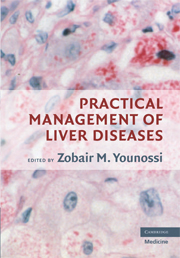Book contents
- Frontmatter
- Contents
- Preface
- Contributors
- 1 Acute Viral Hepatitis
- 2 Chronic Hepatitis B and D
- 3 Chronic Hepatitis C
- 4 HIV and Viral Hepatitis
- 5 Nonalcoholic Fatty Liver Disease
- 6 Alcoholic Liver Disease
- 7 Genetic Hemochromatosis and Iron Overload
- 8 Wilson's Disease
- 9 Alpha-1 Antitrypsin Deficiency and the Liver
- 10 Autoimmune Liver Disease
- 11 Drug-Induced Liver Disease (DILI)
- 12 Benign and Malignant Tumors of the Liver
- 13 Complications of Cirrhosis
- 14 Liver Transplantation
- 15 Novel Technologies in Studying Chronic Liver Disease
- Index
- References
8 - Wilson's Disease
Published online by Cambridge University Press: 08 August 2009
- Frontmatter
- Contents
- Preface
- Contributors
- 1 Acute Viral Hepatitis
- 2 Chronic Hepatitis B and D
- 3 Chronic Hepatitis C
- 4 HIV and Viral Hepatitis
- 5 Nonalcoholic Fatty Liver Disease
- 6 Alcoholic Liver Disease
- 7 Genetic Hemochromatosis and Iron Overload
- 8 Wilson's Disease
- 9 Alpha-1 Antitrypsin Deficiency and the Liver
- 10 Autoimmune Liver Disease
- 11 Drug-Induced Liver Disease (DILI)
- 12 Benign and Malignant Tumors of the Liver
- 13 Complications of Cirrhosis
- 14 Liver Transplantation
- 15 Novel Technologies in Studying Chronic Liver Disease
- Index
- References
Summary
BACKGROUND
Wilson's disease or hepatolenticular degeneration, is an autosomal-recessive disorder in which the primary biochemical abnormality resides in the liver, leading to the accumulation of copper in various tissues notably the hepatocytes and the basal ganglia. Its clinical presentation ranges from asymptomatic abnormal elevations of liver enzymes to fulminant liver failure, psychological and neurological disturbances. Although the disorder is uncommon occurring in 1/30,000 individuals, early diagnosis is important because effective therapy with chelating agents is available to prevent permanent liver and brain damage. Liver transplantation corrects the primary biochemical abnormality, thus curing the liver disease and is lifesaving in fulminant hepatic failure. Although it could improve the neurological manifestations, liver transplantation has not shown to reverse advanced brain damage.
PATHOPHYSIOLOGY
Copper is an essential trace element involved in key enzyme activities. However, the excess of copper is toxic and postulated to cause free oxygen radical formation, mitochondrial damage, lipid peroxidation, and triglyceride accumulation in the cells.
In the normal state, copper is absorbed in the duodenum and jejunum and transported in the portal circulation to the liver. In the Golgi apparatus of the liver, copper binds to various proteins or metallothioneins such as apoceruloplasmin to form ceruloplasmin the major copper binding protein synthesized in the liver. The synthesis of ceruloplasmin and the excretion of copper in bile, its main route of elimination, are essential in maintaining copper homeostasis. Any disruption along this pathway would result in copper accumulation and disease.
- Type
- Chapter
- Information
- Practical Management of Liver Diseases , pp. 131 - 139Publisher: Cambridge University PressPrint publication year: 2008



